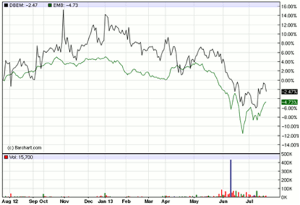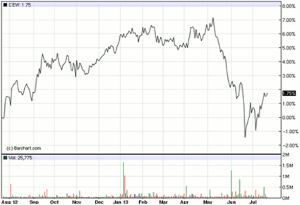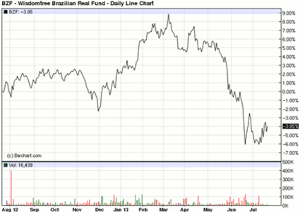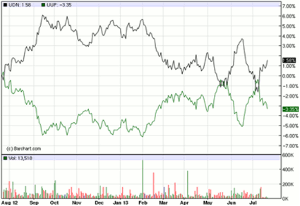While a surging US dollar might be good news for the US economy, it’s not great for these five exchange-traded funds, notes Carolyn Pairitz of ETFdb.com.
As the US market continues to recover, Ben Bernanke has announced his loose plan to wean the economy off the federal money it has relied on heavily since 2008. While this is good news for the future of investing and will strengthen economic conditions in the long term, many investors have been overly flighty during transition discussions. In recent months, the dollar and bond rates have fallen a number of times before Bernanke has spoken, only to bounce back stronger than before once he finishes. While the dollar seems to finally be on the way up, this is not great news for all investors and has really affected the returns of a number of ETFs.
1. iShares JP Morgan USD Emerging Markets Bond ETF (EMB)
After climbing high for months, EMB started to slip in the winter before taking a huge dive in the summer. While other emerging market funds also tanked in the early summer months, funds like the iShares Emerging Markets Local Currency Bond ETF (LEMB) do not have the added hardship of a strong dollar to bring their returns down even more.
2. iShares MSCI Emerging Markets ETF (EEM)
This once popular fund has seen massive outflows as investors migrate back to developed markets while conditions improve at home. While EEM takes a straight approach to emerging stock market exposure, funds like db X-trackers MSCI Emerging Markets Hedged Equity Fund (DBEM), which are designed to mitigate the fluctuation between the value of the US dollar and non-US currencies, have been able to avoid the strong dollar effect on returns.
3. Dreyfus Emerging Currency Fund (CEW)
Offering exposure to the local currencies of China, Russia, and Mexico, to name a few, was a strong idea when these countries were competing with a weak dollar and had rising economies. As the tables turned, CEW took a massive hit and lost the momentum it had built through the winter and spring.
4. Dreyfus Brazilian Real Fund (BZF)
One of the largest disappointments for emerging market investors, Brazil has lost the steam it had for nearly a decade, with the economy only worsening following a number of uprisings in major cities. While many emerging market currency funds have taken losses with the strengthening US dollar, none were hit as hard as BZF.
5. DB USD Index Bullish (UUP) or Bearish (UDN)
Both of these funds have fluctuated wildly as announcements from the Fed have inspired investors one week while sending them running the next. UUP invests in long futures contracts of the US dollar against the euro, Japanese yen, British pound, Canadian dollar, Swedish krona, and Swiss franc, while UDN invests in the short contracts to provide inverse exposure. After a rough fall in 2012, UUP has been unable to recover sufficiently to show the growing US dollar value and has been easily beaten by UDN, which was having a great winter before February.
By Carolyn Pairitz, Contributor, ETFdb.com


























